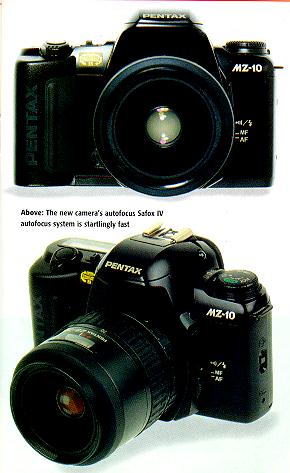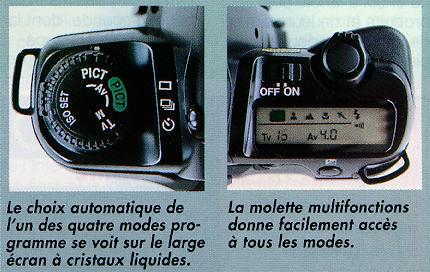

Note: The following information is taken from the English magazine
"Amateur Photographer" issue of the week ending 27 July 1996. There may
be errors in it.
There was a test in the August issue of Buying Camera, but I haven't see it.
Here is a summary by someone who did.
I also used info on the (short) review included in the Spetember issue
of the French magazine "Photo".
Dimensions: It is similar to the MZ-5 (135 x 90.5 x 62.5 mm) except that it is lighter (350 g). One thing made to reduce weight is the use of a plastic lens mount :( Another is that the viewfinder uses a mirror box, not a glass pentaprism. But that is also used in most Pentax cameras.
Pentax has also another lower-priced camera (MZ-50/ZX-50). Its most important difference relatively to the MZ-10 is the abandon of total compability with K-mount lenses. Old lenses (pre A, that is M series or older) lose metering in it. The reason is that, in the MZ-50, the lens must be in the A-position in all modes, so lenses without a A position don't work well.
Exposure modes: It has all the usual programs (action, portrait, landscape, macro, green) and other modes (shutter priority, aperture priority, metered manual, bulb) that a Z-70 has. It is not clear if there is a shiftable program.
The new feature of this camera is a "smart" mode: in that mode the camera decides for itself which of the specialized modes you need. This kind of thing was a failure in the Minolta xi series, from what I have read, but as Pentax has kept the manual selection of those programs, I expect it to fare better.
Continuing with the Pentax tradition of showing what the camera is doing in the automatic modes, the top screen shows which program the camera has chosen to be appropriate.

In my opinion a very interesting combination of old and new ideas in ergonomics.
The exposure system uses a 6 zones matrix. The same as the MZ-5, Z-20,
etc...
Metering range: EV 0 to EV 21 with a f/1.4 lens.
Exposure compensation (+- 3EV in 1/2 EV steps).
Complete DX code (25-5000) with manual override (6-6400).
An exposure lock ! (the first time this appears in a non-high end AF
camera. I hope it is not a magazine error.)

The shutter has the same characteristics of the ones in the Z-20, Z-70, etc... 1/100 flash sync, 1/2000 maximum speed. Relatively to the MZ-5, it has recovered the long speeds (4s-30s) in manual mode and shutter priority. It also probably recovered half speeds. When the camera choses the speed, it is stepless.
The AF system is the same as in the MZ-5. Usable at EV 1 to EV 18 with a f/1.4 lens. Still no continuous focusing mode. It has the predictive focus as in the other low-end Pentaxes.
The lens mount (plastic) is a KAF2. This includes power contacts for
the power zoom, but the only automatism involving the zoom is to
retract the lens when the camera is turned off.
The winder speed is the same as usual (2fps). Also usual drive modes (single, continuous, self-timer (12s)).
The built-in flash covers 28mm and has a GN of 11m.
The magazines says it doesn't have a cable release socket, but the cover of it is (barely) visible on the photo above (usual position).
There is Panorama Date version, with Panorama mode (13x36mm) and Date back, as usual in the Japanese market. A version without those will also be available.
One thing which is not obvious is how shutter speeds, etc... are selected. The camera has lost the small wheel used in the Z-20 and Z-70. Apparently the small button on the left of the shutter release is used instead. But it might also be the lever surrounding the shutter, although that looks more like the on-off switch.